The Dynamics of Cyclical Convergence and Decoupling in the Environmental Performance of Spanish Regions
Abstract
1. Introduction
2. Methods and Data
- Duration of the phase is observed according to its length along the abscissa axis.
- Amplitude would be the height of the phase, which is observed as it increases or decreases on the ordinate axis.
- Intensity relates to the amplitude and duration of each phase, such that if the phase has more amplitude and shorter duration, it is more intense and more pronounced graphically.
3. Analysis Results
3.1. Spanish Cyclical Performance of CO2 Emissions
3.2. The Dynamics of Cyclical Convergence and Decoupling
3.3. Robustness Checks
4. Discussion and Conclusions
Author Contributions
Funding
Acknowledgments
Conflicts of Interest
References
- Teng, X.; Chun Lu, L.; Chiu, Y. How the European Union reaches the target of CO2 emissions under the Paris Agreement. Eur. Plan. Stud. 2020, 28, 1836–1857. [Google Scholar] [CrossRef]
- Delgado Rodríguez, M.J.; Cabezas Ares, A.; de Lucas Santos, S. Cyclical fluctuation patterns and decoupling: Towards common EU-28 environmental performance. J. Clean. Prod. 2018, 175, 696–706. [Google Scholar] [CrossRef]
- Villar-Rubio, E.; Huete-Morales, M.D. Market Instruments for a Sustainable Economy: Environmental Fiscal Policy and Manifest Divergences. Rev. Policy Res. 2017, 34, 255–269. [Google Scholar] [CrossRef]
- González-Vallejo, P.; Muntean, R.; Solís-Guzmán, J.; Marrero, M. Carbon Footprint of Dwelling Construction in Romania and Spain. A Comparative Analysis with the OERCO2 Tool. Sustainability 2020, 12, 6745. [Google Scholar] [CrossRef]
- Borozan, D. Testing for convergence in electricity consumption across Croatian regions at the consumer’s sectoral level. Energy Policy 2018, 102, 145–153. [Google Scholar] [CrossRef]
- Bhattacharya, M.; Inekwe, J.N.; Sadorsky, P.; Saha, A. Convergence of energy productivity across Indian states and territories. Energy Econ. 2018, 74, 427–440. [Google Scholar] [CrossRef]
- Ivanovski, K.; Awaworyi Churchill, S.; Smyth, R. A club convergence analysis of per capita energy consumption across Australian regions and sectors. Energy Econ. 2018, 76, 519–531. [Google Scholar] [CrossRef]
- Cheong, T.S.; Li, V.J.; Shi, X. Regional disparity and convergence of electricity consumption in China: A distribution dynamics approach. China Econ. Rev. 2019, 58. [Google Scholar] [CrossRef]
- Apergis, N.; Payne, J.E. Per capita carbon dioxide emissions across U.S. states by sector and fossil fuel source: Evidence from club convergence tests. Energy Econ. 2017, 63, 365–372. [Google Scholar] [CrossRef]
- Actividad legislativa del Ministerio para la Transición Ecológica y el Reto Demogáfico de España. Available online: https://www.miteco.gob.es/es/ministerio/actividad-legislativa/default.aspx (accessed on 30 July 2020).
- Apergis, N.; Garzón, A.J. Greenhouse gas emissions convergence in Spain: Evidence from the club clustering approach. Environ. Sci. Pollut. Res. 2020, 27, 38602–38606. [Google Scholar] [CrossRef] [PubMed]
- García-Gusano, D.; Suárez-Botero, J.; Dufour, J. Long-term modelling and assessment of the energy-economy decoupling in Spain. Energy 2018, 151, 455–466. [Google Scholar] [CrossRef]
- Cansino, J.M.; Sánchez-Braza, A.; Rodríguez-Arévalo, M.L. Driving forces of Spain’s CO2 emissions: A LMDI decomposition approach. Renew. Sustain. Energy Rev. 2015, 48, 749–759. [Google Scholar] [CrossRef]
- Ruiz-Fuensanta, M.J. The region matters: A comparative analysis of regional energy efficiency in Spain. Energy 2016, 101, 325–331. [Google Scholar] [CrossRef]
- Quesada-Rubio, J.M.; Villar-Rubio, E.; Mondéjar-Jiménez, J.; Molina-Moreno, V. Carbon dioxide emissions vs. allocation rights: Analysis of the Spanish case. Int. J. Environ. Res. 2011, 5, 469–474. [Google Scholar] [CrossRef]
- Cendejas Bueno, J.L.; Lucas Santos S de Delgado Rodríguez, M.J.; Álvarez Ayuso, I. Testing for structural breaks in factor loadings: An application to international business cycle. Econ. Model. 2011, 28, 259–263. [Google Scholar] [CrossRef][Green Version]
- Harding, D.; Pagan, A. Dissecting the cycle: A methodological investigation. J. Monet. Econ. 2002, 49, 365–381. [Google Scholar] [CrossRef]
- De la Fuente, A. Long Series of Some Regional Economic and Demographic Aggregates (RegData and RegData Dem Vers. 5.0-2018). 2019. Available online: https://www.bbvaresearch.com/tag/regdata/ (accessed on 31 August 2020).
- Stock, J.H.; Watson, M.W. Dynamic Factor Models. In The Oxford Handbook of Economic Forecasting; Oxford University Press: Oxford, UK, 2012. [Google Scholar] [CrossRef]
- Dubois, É.; Michaux, E. Grocer 1.72: An Econometric Toolbox for Scilab. Available online: https://atoms.scilab.org/toolboxes/grocer/1.72 (accessed on 1 September 2020).
- Bai, J.; Ng, S. Determining the number of primitive shocks in factor models. J. Bus. Econ. Stat. 2007, 25, 52–60. [Google Scholar] [CrossRef]
- Andrews, D.W.K. Estimation when a parameter is on a boundary. Econometrica 1999, 67, 1341–1383. [Google Scholar] [CrossRef]
- Tapio, P. Towards a theory of decoupling: Degrees of decoupling in the EU and the case of road traffic in Finland between 1970 and 2001. Transp. Policy 2005, 12, 137–151. [Google Scholar] [CrossRef]
- Jiang, R.; Zhou, Y.; Li, R. Moving to a Low-Carbon Economy in China: Decoupling and Decomposition Analysis of Emission and Economy from a Sector Perspective. Sustainability 2018, 10, 978. [Google Scholar] [CrossRef]
- Qiu, L.; Huang, J.; Niu, W. Decoupling and Driving Factors of Economic Growth and Groundwater Consumption in the Coastal Areas of the Yellow Sea and the Bohai Sea. Sustainability 2018, 10, 4158. [Google Scholar] [CrossRef]
- Doda, B. Evidence on business cycles and CO2 emissions. J. Macroecon. 2014, 40, 214–227. [Google Scholar] [CrossRef]
- Bai, J.; Ng, S. Determining the Number of Factors in Approximate Factor Models. Econometrica 2002, 70, 191–221. [Google Scholar] [CrossRef]
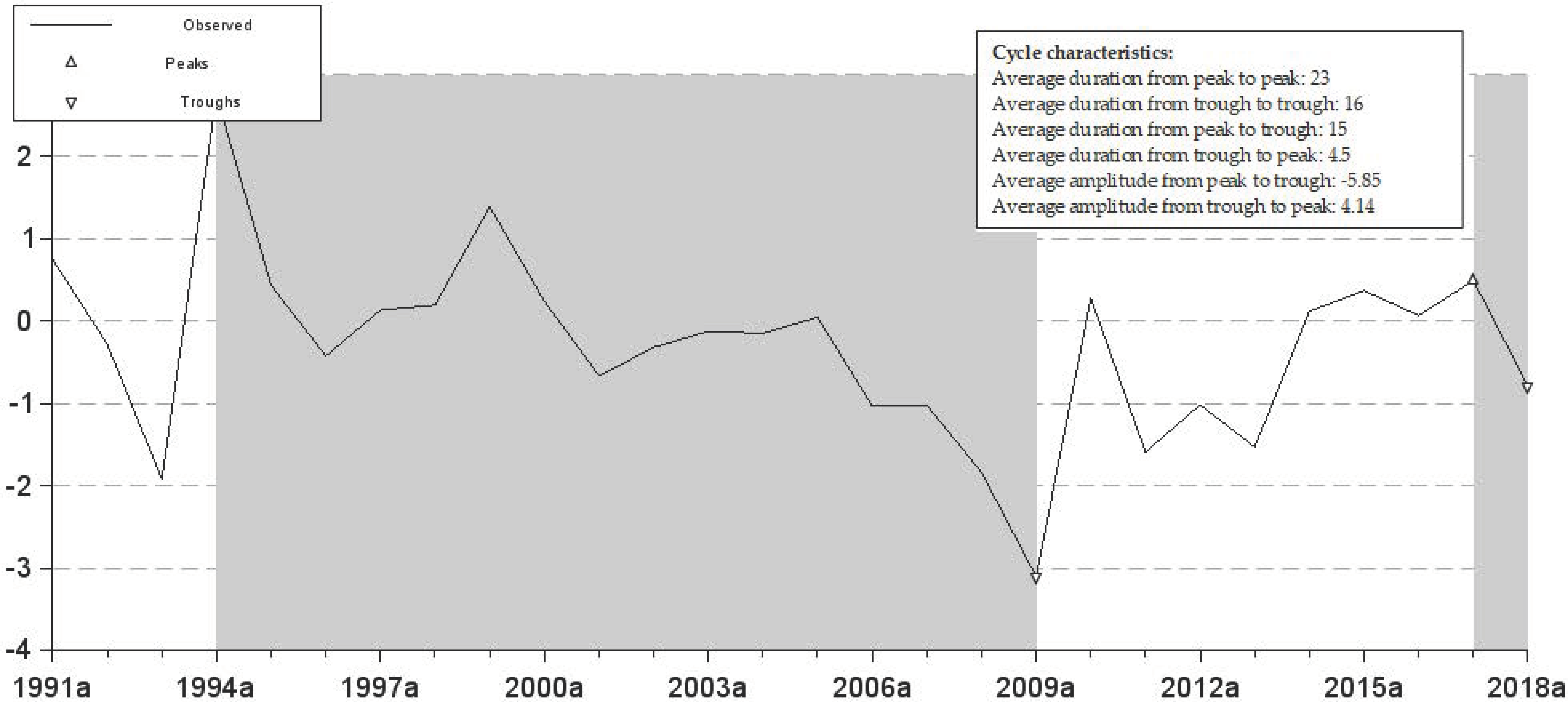

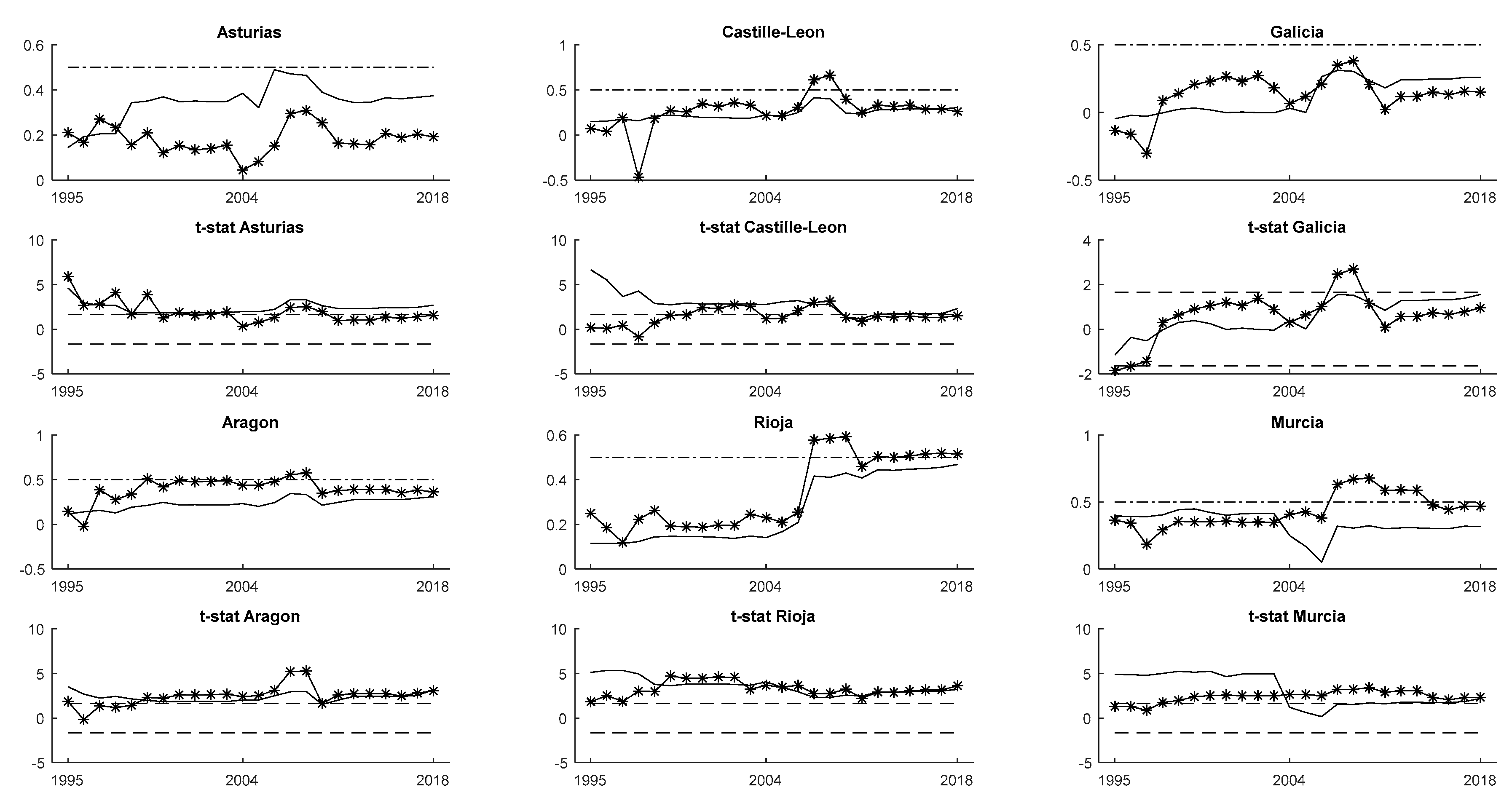
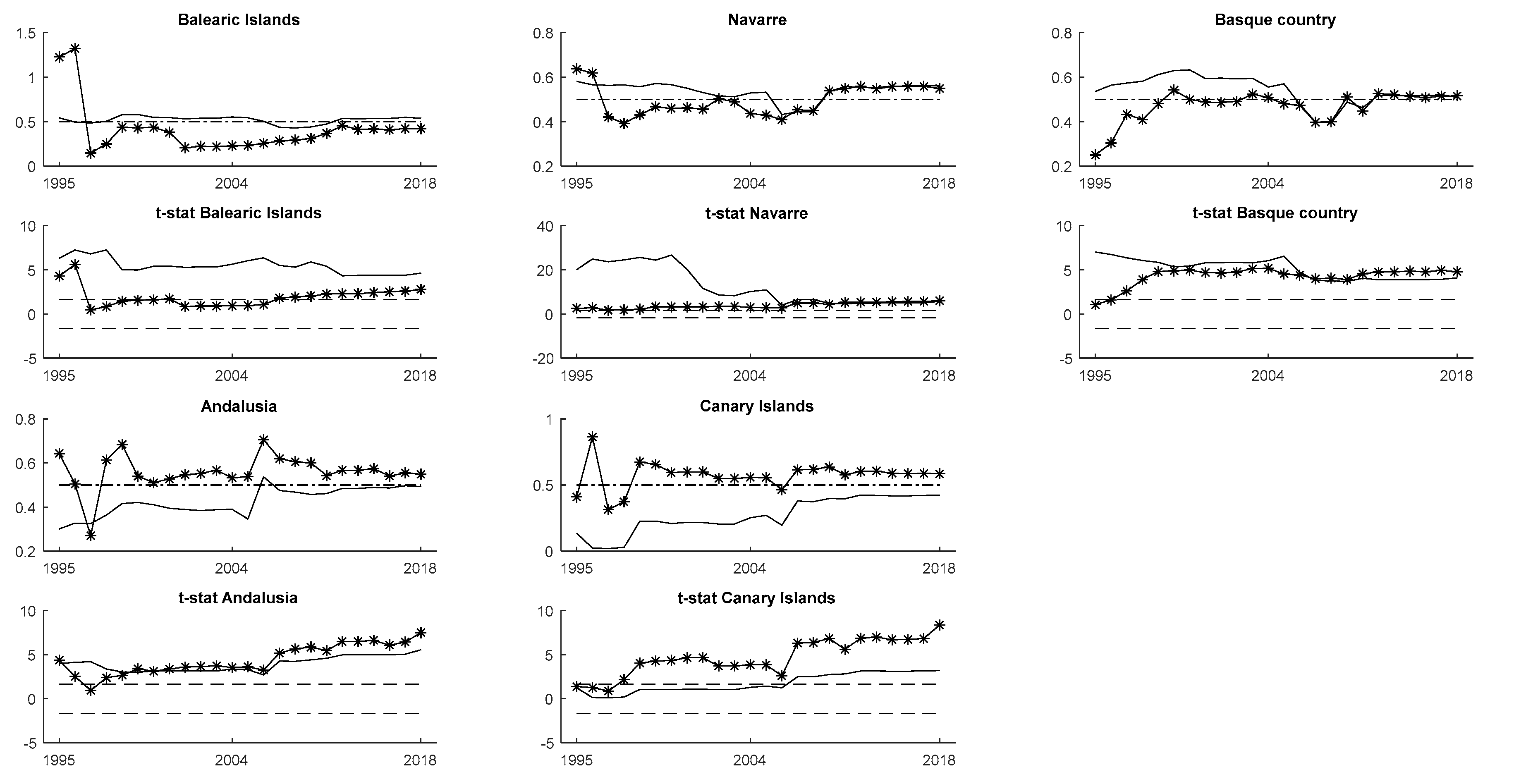
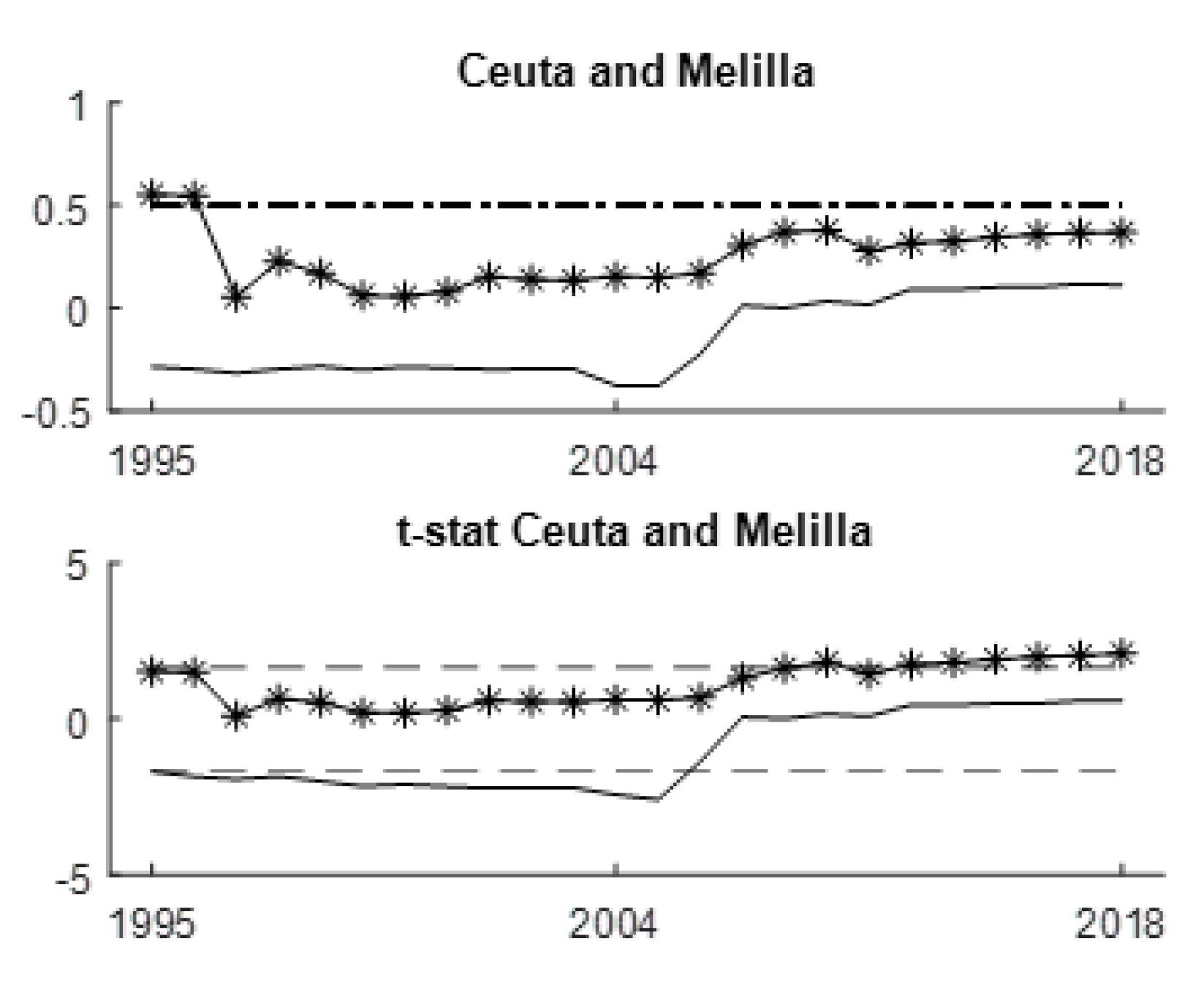
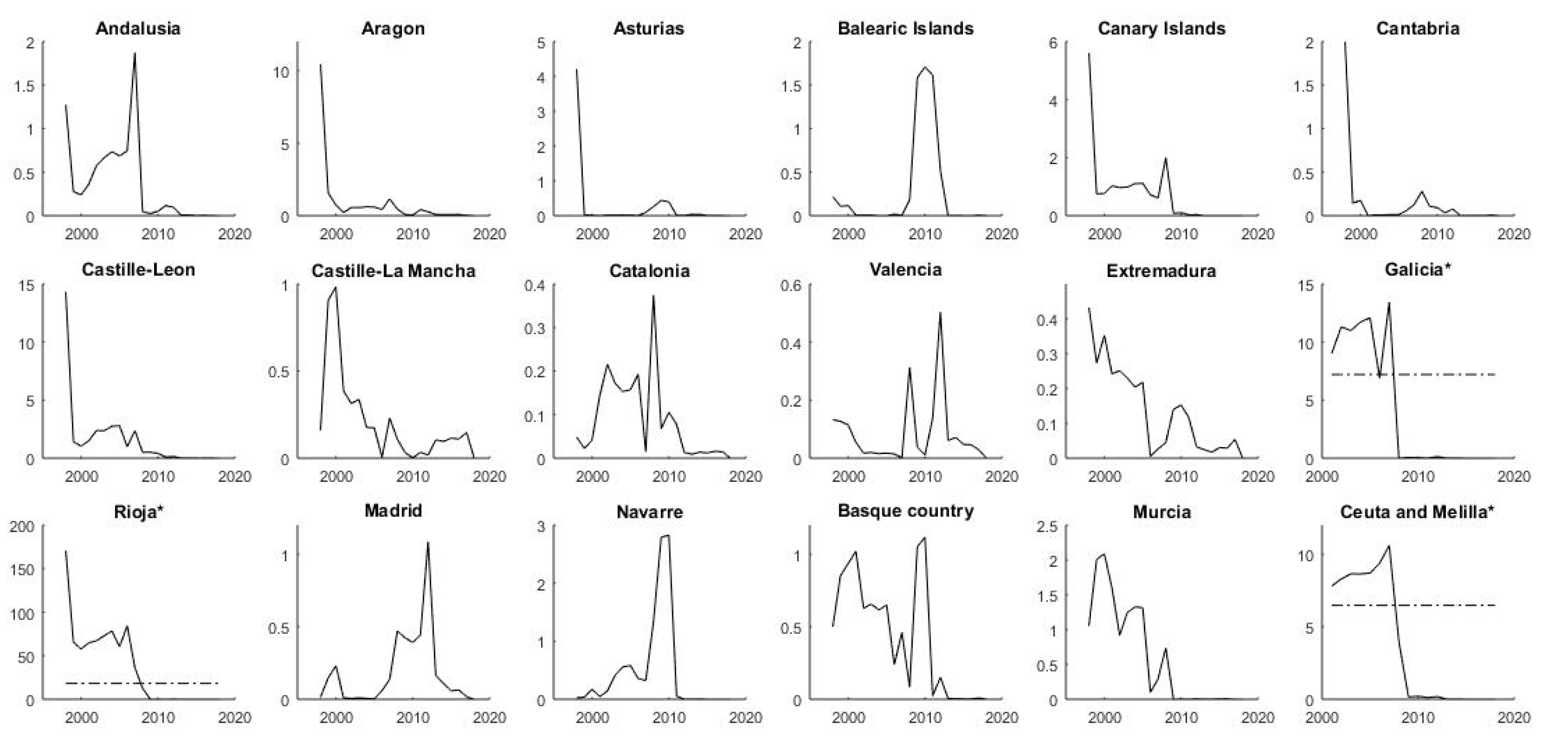
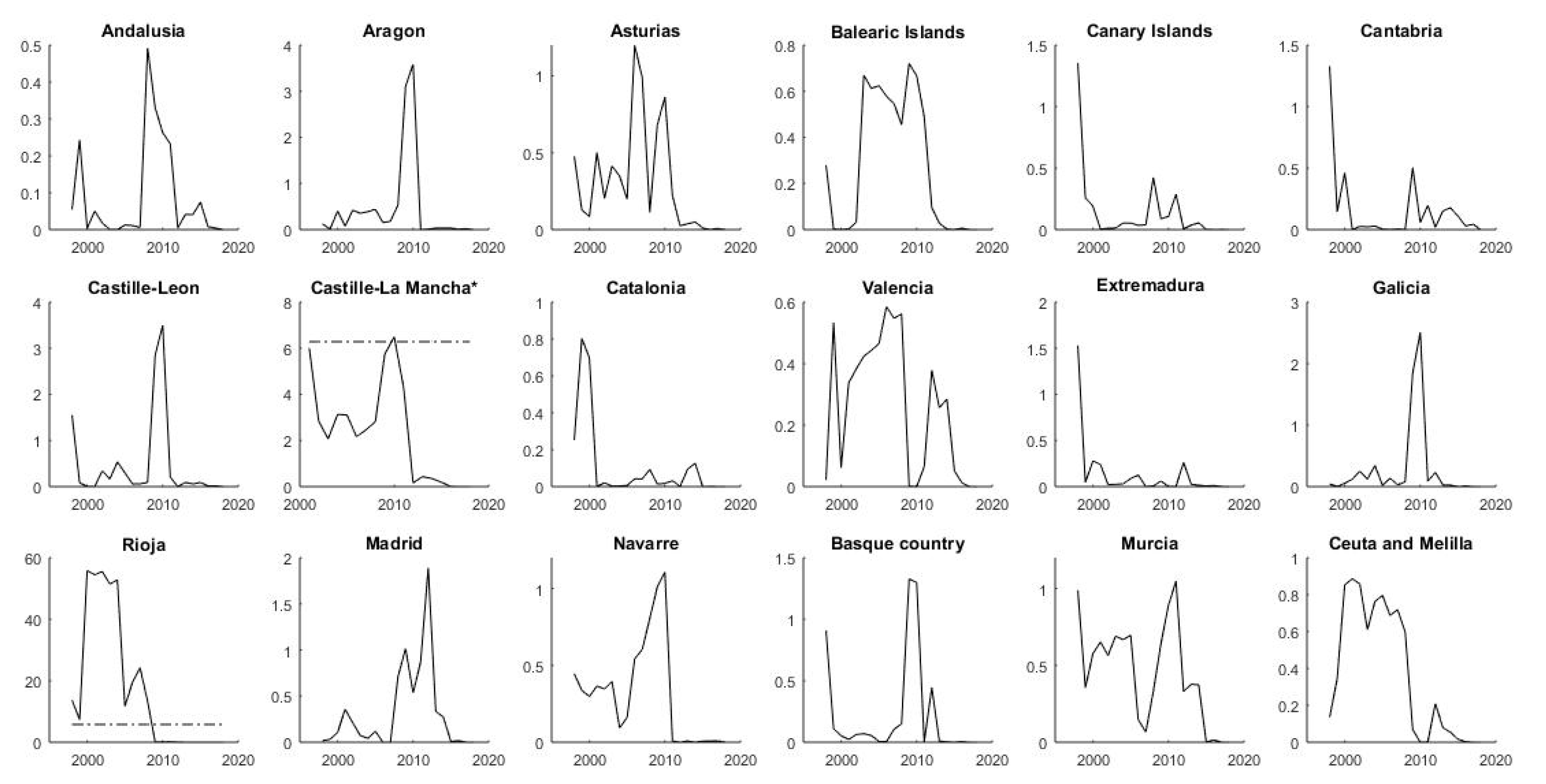
| UE Legislation | Spanish Legislation |
|---|---|
|
|
| 29/04/1998 Spain signed the Kyoto Protocol, and ratified the Protocol on 31/05/2002 | |
|
|
| 22/04/2016 Spain signed the Paris Agreement, and ratified the Agreement on 12/01/2017 | |
|
|
| CCAA | Factor Loadings | AR Parameters | Residual Variance |
|---|---|---|---|
| Andalusia | 0.51 (5.01) *** | −0.35 (−1.81) * | 0.39 (3.45) *** |
| Aragon | 0.26 (3.01) *** | −0.53 (−3.27) *** | 0.6 (3.69) *** |
| Asturias | 0.29 (2.89) *** | −0.34 (−1.86) * | 0.69 (3.69) *** |
| Balearic Islands | 0.48 (4.16) *** | −0.09 (−0.43) | 0.52 (3.55) *** |
| Canary Islands | 0.42 (4.03) *** | −0.34 (−1.86) * | 0.59 (3.61) *** |
| Cantabria | 0.4 (3.49) *** | −0.15 (−0.77) | 0.62 (3.64) *** |
| Castille-Leon | 0.27 (2.37) *** | −0.22 (−1.16) | 0.8 (3.7) *** |
| Castille-La Mancha | 0.58 (6.03) *** | −0.49 (−2.46) *** | 0.19 (2.85) *** |
| Catalonia | 0.52 (4.4) *** | 0.09 (0.44) | 0.43 (3.45) *** |
| Valencia | 0.54 (4.91) *** | −0.1 (−0.47) | 0.38 (3.41) *** |
| Extremadura | 0.54 (5.11) *** | −0.13 (−0.6) | 0.34 (3.36) *** |
| Galicia | 0.32 (2.89) *** | −0.24 (−1.28) | 0.74 (3.68) *** |
| Rioja | 0.42 (3.5) *** | 0 (−0.01) | 0.61 (3.61) *** |
| Madrid | 0.54 (5.14) *** | −0.34 (−1.77) | 0.39 (3.41) *** |
| Navarre | 0.43 (3.4) *** | 0.17 (0.84) | 0.58 (3.58) *** |
| Basque Country | 0.4 (3.83) *** | −0.28 (−1.49) | 0.57 (3.62) *** |
| Murcia | 0.33 (2.43) *** | 0.12 (0.61) | 0.78 (3.68) *** |
| Regions | Trimming | 90% | 95% | 99% | Break Date | Breaks | |
|---|---|---|---|---|---|---|---|
| Andalusia | 30% | 18.7 | 32.6 | 81.1 | 1.9 | 2007 | |
| Aragon | 30% | 17.8 | 33.1 | 83.2 | 10.4 | 1998 | |
| Asturias | 30% | 15.6 | 25 | 55 | 4.2 | 1998 | |
| Balearic Island | 30% | 19.3 | 28 | 111.2 | 1.7 | 2010 | |
| Canary Island | 30% | 18.1 | 28.5 | 74 | 5.6 | 1998 | |
| Cantabria | 30% | 15.6 | 25.4 | 59.1 | 2 | 1998 | |
| Castille-Leon | 30% | 16.8 | 27.6 | 77.7 | 14.3 | 1998 | |
| Castille-La Mancha | 30% | 17.3 | 27.3 | 57.5 | 1 | 2000 | |
| Catalonia | 30% | 15.3 | 23.9 | 65.5 | 0.4 | 2008 | |
| Valencia | 30% | 16.2 | 25 | 110.7 | 0.5 | 2012 | |
| Extremadura | 30% | 16.7 | 28.7 | 99.7 | 0.4 | 1998 | |
| Galicia | 40% | 7.2 | 11.2 | 31.3 | 13.4 | 2007 ** | Temporal break |
| Rioja | 40% | 8.8 | 13.8 | 34.8 | 84.4 | 2006 *** | Temporal break |
| Madrid | 30% | 15.1 | 27.9 | 68 | 1.1 | 2012 | |
| Navarre | 30% | 17.6 | 28.9 | 74.3 | 2.8 | 2010 | |
| Basque Country | 30% | 16.1 | 29.2 | 65.6 | 1.1 | 2010 | |
| Murcia | 30% | 17.7 | 27.6 | 75.8 | 2.1 | 2000 | |
| Ceuta and Melilla | 40% | 6.5 | 9.1 | 21.3 | 10.6 | 2007 ** | Structural break |
| Regions | Trimming | 90% | 95% | 99% | Break Date | Breaks | |
|---|---|---|---|---|---|---|---|
| Andalusia | 30% | 7.3 | 13.2 | 29.4 | 0.5 | 2008 | |
| Aragon | 30% | 9.1 | 14.8 | 31.8 | 3.6 | 2010 | |
| Asturias | 30% | 14.5 | 24.1 | 67.1 | 1.2 | 2006 | |
| Balearic Island | 30% | 7.9 | 12 | 23.9 | 0.7 | 2009 | |
| Canary Island | 30% | 8 | 13.1 | 44.7 | 1.4 | 1998 | |
| Cantabria | 30% | 6.9 | 12.6 | 25.1 | 1.3 | 1998 | |
| Castille-Leon | 30% | 18.3 | 30.5 | 89.9 | 3.5 | 2010 | |
| Castille-la Mancha | 40% | 6.3 | 9.7 | 18.5 | 6.5 | 2010 * | Temporal break |
| Catalonia | 30% | 5.4 | 8 | 15.9 | 0.8 | 1999 | |
| Valencia | 30% | 3.8 | 5.5 | 14.6 | 0.6 | 2006 | |
| Extremadura | 30% | 6.3 | 9.2 | 19.3 | 1.5 | 1998 | |
| Galicia | 30% | 13.2 | 21.3 | 56.6 | 2.5 | 2010 | |
| Rioja | 30% | 5.8 | 8.9 | 23 | 55.8 | 2000 *** | Temporal break |
| Madrid | 30% | 3.9 | 6.2 | 14.6 | 1.9 | 2012 | |
| Navarra | 30% | 4.8 | 6.9 | 15.6 | 1.1 | 2010 | |
| Basque Country | 30% | 4.6 | 7.7 | 14.1 | 1.3 | 2009 | |
| Murcia | 30% | 5.4 | 8.4 | 15.5 | 1 | 2011 | |
| Ceuta and Melilla | 30% | 5.3 | 8.6 | 19.3 | 0.9 | 2001 |
Publisher’s Note: MDPI stays neutral with regard to jurisdictional claims in published maps and institutional affiliations. |
© 2020 by the authors. Licensee MDPI, Basel, Switzerland. This article is an open access article distributed under the terms and conditions of the Creative Commons Attribution (CC BY) license (http://creativecommons.org/licenses/by/4.0/).
Share and Cite
Cabezas-Ares, A.; Delgado-Rodríguez, M.J.; Lucas-Santos, S.d. The Dynamics of Cyclical Convergence and Decoupling in the Environmental Performance of Spanish Regions. Sustainability 2020, 12, 8569. https://doi.org/10.3390/su12208569
Cabezas-Ares A, Delgado-Rodríguez MJ, Lucas-Santos Sd. The Dynamics of Cyclical Convergence and Decoupling in the Environmental Performance of Spanish Regions. Sustainability. 2020; 12(20):8569. https://doi.org/10.3390/su12208569
Chicago/Turabian StyleCabezas-Ares, Alfredo, María Jesús Delgado-Rodríguez, and Sonia de Lucas-Santos. 2020. "The Dynamics of Cyclical Convergence and Decoupling in the Environmental Performance of Spanish Regions" Sustainability 12, no. 20: 8569. https://doi.org/10.3390/su12208569
APA StyleCabezas-Ares, A., Delgado-Rodríguez, M. J., & Lucas-Santos, S. d. (2020). The Dynamics of Cyclical Convergence and Decoupling in the Environmental Performance of Spanish Regions. Sustainability, 12(20), 8569. https://doi.org/10.3390/su12208569







